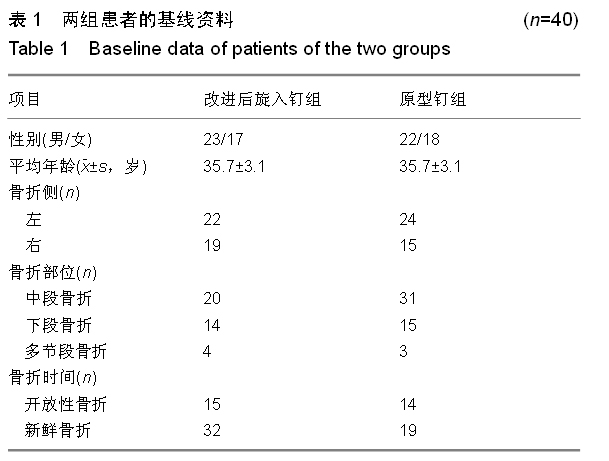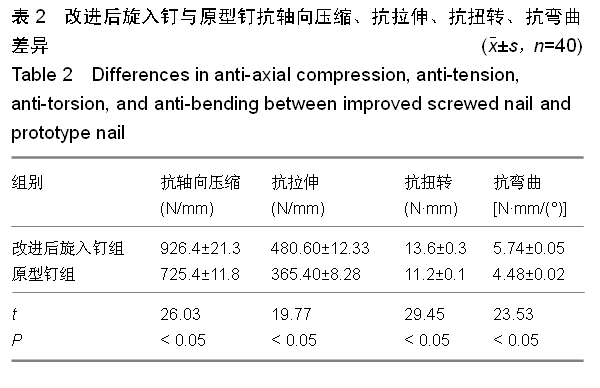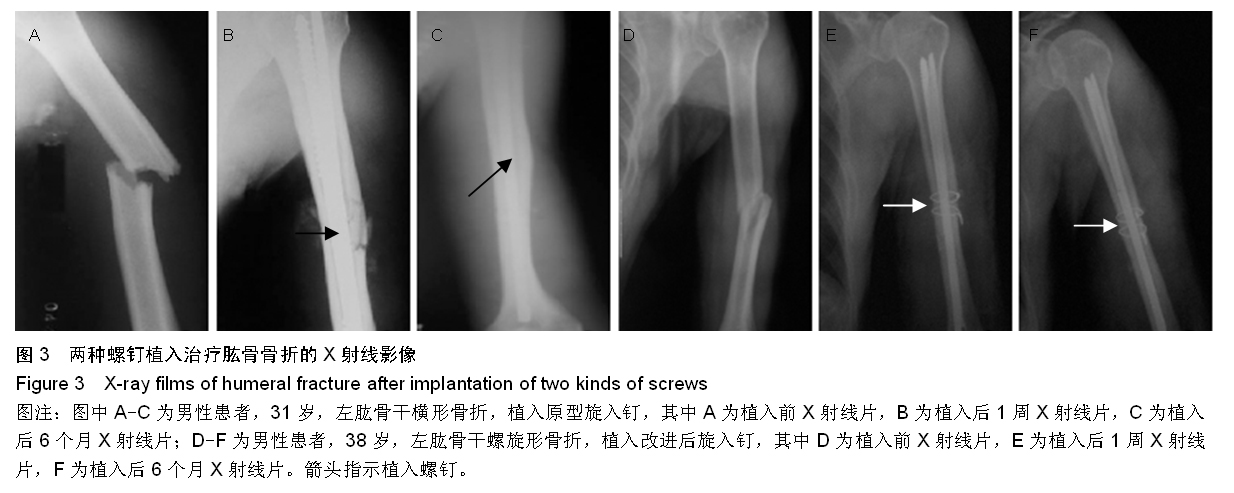| [1] 刘国栋,魏春群,王书明,等.带锁旋入式髓内针治疗肱骨骨折[J].生物骨科材料与临床研究,2008,5(5):41-42.
[2] 李长胜.旋入式自锁髓钉治疗肱骨干骨折40例分析[J].山西医药杂志(下半月版),2008,37(22):994-995.
[3] 韩伟,田晓滨,李波,等.旋入式自锁髓内钉与加压钢板治疗20例肱骨骨折疗效分析[J].贵州医药,2008,32(8):729.
[4] 姚仁福.旋入式自锁髓内钉在肱骨干骨折中的应用[J].解剖与临床,2008,13(6):439-440.
[5] 姜泳,姬常功,位学东.旋入式自锁髓内钉在肱骨骨折治疗中的应用[J].临床骨科杂志,2008,11(4):375.
[6] 刘云华,王伟,谢文军,等.旋入式自锁髓内针治疗肱骨干骨折32例分析[J].检验医学与临床,2009,6(14):1190-1191.
[7] 向峥,郭振河,李敬中,等.旋入式髓内钉微创治疗肱骨干骨折的疗效分析[J].中国矫形外科杂志,2007,15(12):898-900.
[8] 李春青,洪云峰,杨荣华,等.逆行旋入式自锁髓内钉治疗肱骨骨折[J].实用骨科杂志,2009,15(10):781-782.
[9] 韩一生,赵广跃,刘建,等.非扩髓型肱骨内锁髓内钉的研制和临床应用[J].中华骨科杂志,1997,17(4):229-232.
[10] 李振年,刘斌成,徐继新,等.带锁髓内针与旋入式自锁髓内针治疗长管状骨干骨折的比较[J].中国现代药物应用,2010,4(6):33-34.
[11] 尤微,王大平,熊建义.顺行旋入式髓内钉治疗肱骨干骨折疗效观察[J].中国现代手术学杂志,2008,12(4):280-282.
[12] 臧伟,刘云峰,武全民.微创旋入钉内固定技术治疗伴桡神经麻痹的肱骨干中下段骨折[J].中国骨伤,2009,22(7):515-517.
[13] 马胜忠,李明,侯铁胜.骨质疏松性脊柱压缩性骨折的手术治疗[J].中国矫形外科杂志,2002,9(6):603-604.
[14] Jeon SW, Jeong JH, Choi GH, et al. Clinical outcome of posterior fixation of the C1 lateral mass and C2 pedicle by polyaxial screw and rod. Clin Neurol Neurosurg. 2012;114(6): 539-544.
[15] 池永龙,林焱,毛方敏,等.几种椎弓根钉内固定器的生物力学测试与临床应用[J].中国脊柱脊髓杂志,2001,11(3):78-80.
[16] Meyer D, Meyer F, Kretschmer T, et al. Translaminar screws of the axis--an alternative technique for rigid screw fixation in upper cervical spine instability. Neurosurg Rev. 2012;35(2): 255-261;discussion 261.
[17] Pelton MA, Schwartz J, Singh K. Subaxial cervical and cervicothoracic fixation techniques--indications, techniques, and outcomes. Orthop Clin North Am. 2012; 43(1):19-28, vii.
[18] 陈德龙,陈小龙,向道友,等.椎弓根螺钉在多节段胸腰椎骨折的应用[J].西部医学,2008,20(5):967-968.
[19] 王洪伟,李长青,周跃,等.脊柱骨折经伤椎椎弓根置钉附加横连短节段固定的稳定性测试[J].中国脊柱脊髓杂志,2010,20(9): 745-749.
[20] 丁援建,陈智良,赵谦,等.个体化选定椎弓根螺钉入钉点治疗胸腰段脊柱骨折[J].中国脊柱脊髓杂志,2003,13(6):364-367.
[21] Panjabi MM. Biomechanical evaluation of spinal fixation devices: I. A conceptual framework. Spine (Phila Pa 1976). 1988;13(10):1129-1134.
[22] Dick JC, Jones MP, Zdeblick TA, et al. A biomechanical comparison evaluating the use of intermediate screws and cross-linkage in lumbar pedicle fixation. J Spinal Disord. 1994; 7(5):402-407.
[23] 胡樵,黄勇,赵东升,等.胸腰椎骨折伤椎椎弓根内固定的生物力学研究[J].河北医学,2008,14(7):757-758.
[24] 魏美钢,王坤正,侯德门,等.椎弓根螺钉器械横杆作用的生物力学研究[J].西安医科大学学报,2002,23(1):47-49.
[25] 殷渠东,郑祖根,蔡建平,等.椎弓根螺钉固定相对稳定性的体外生物力学试验[J].江苏医药,2005,31(2):119-122.
[26] 武启军,王自立,戈朝晖,等.脊柱单节段前中柱切除后不同节段椎弓根螺钉内固定的稳定性测试[J].中国脊柱脊髓杂志,2010, 20(4):267-269.
[27] 王志荣,杨惠林,王根林.胸腰椎椎弓根螺钉内固定系统的设计进展[J].中国脊柱脊髓杂志,2008,18(10):791-794.
[28] 王向阳,池永龙.加强和维持椎弓根螺钉系统稳定性的研究进展[J].中国矫形外科杂志,2002,9(1):57-59.
[29] 王岩,卢世璧,张永刚,等.形状记忆合金脊柱侧凸矫正系统的设计与临床应用[J].中国矫形外科,2005,13(17):1289-1292.
[30] 邵景范,Sarkar MR,Claes IE,等.新型陶瓷改善椎弓根螺钉稳定性的研究[J].华中科技大学学报(医学版),2002,31(3):307-309.
[31] Nakashima H, Yukawa Y, Imagama S, et al. Complications of cervical pedicle screw fixation for nontraumatic lesions: a multicenter study of 84 patients. J Neurosurg Spine. 2012; 16(3):238-247.
[32] Deen HG, Birch BD, Wharen RE, et al. Lateral mass screw-rod fixation of the cervical spine: a prospective clinical series with 1-year follow-up. Spine J. 2003;3(6):489-495.
[33] Amato V, Giannachi L, Irace C, et al. Accuracy of pedicle screw placement in the lumbosacral spine using conventional technique: computed tomography postoperative assessment in 102 consecutive patients. J Neurosurg Spine. 2010;12(3): 306-313.
[34] Miyamoto H, Sumi M, Uno K. Utility of modified transarticular screw in the middle and lower cervical spine as intermediate fixation in posterior long fusion surgery. J Neurosurg Spine. 2009;11(5):555-561.
[35] Yukawa Y, Kato F, Yoshihara H, et al. Cervical pedicle screw fixation in 100 cases of unstable cervical injuries: pedicle axis views obtained using fluoroscopy. J Neurosurg Spine. 2006; 5(6):488-493.
[36] Richter M, Cakir B, Schmidt R. Cervical pedicle screws: conventional versus computer-assisted placement of cannulated screws. Spine (Phila Pa 1976). 2005;30(20): 2280-2287.
[37] Neo M, Sakamoto T, Fujibayashi S, et al. The clinical risk of vertebral artery injury from cervical pedicle screws inserted in degenerative vertebrae. Spine (Phila Pa 1976). 2005;30(24): 2800-2805.
[38] Ishikawa Y, Kanemura T, Yoshida G, et al. Intraoperative, full-rotation, three-dimensional image (O-arm)-based navigation system for cervical pedicle screw insertion. J Neurosurg Spine. 2011;15(5):472-478.
[39] Pateder DB, Carbone JJ. Lateral mass screw fixation for cervical spine trauma: associated complications and efficacy in maintaining alignment. Spine J. 2006;6(1):40-43.
[40] Ludwig SC, Kramer DL, Balderston RA, et al. Placement of pedicle screws in the human cadaveric cervical spine: comparative accuracy of three techniques. Spine (Phila Pa 1976). 2000;25(13):1655-1667.
[41] Rajasekaran S, Kanna PR, Shetty AP. Safety of cervical pedicle screw insertion in children: a clinicoradiological evaluation of computer-assisted insertion of 51 cervical pedicle screws including 28 subaxial pedicle screws in 16 children. Spine (Phila Pa 1976). 2012;37(4):E216-223.
[42] Uehara M, Takahashi J, Ikegami S, et al. Screw perforation features in 129 consecutive patients performed computer-guided cervical pedicle screw insertion. Eur Spine J. 2014;23(10):2189-2195.
[43] Kawaguchi Y, Nakano M, Yasuda T, et al. Development of a new technique for pedicle screw and Magerl screw insertion using a 3-dimensional image guide. Spine (Phila Pa 1976). 2012;37(23):1983-1988.
[44] Sciubba DM, Noggle JC, Vellimana AK, et al. Radiographic and clinical evaluation of free-hand placement of C-2 pedicle screws. Clinical article. J Neurosurg Spine. 2009;11(1):15-22.
[45] Tauchi R, Imagama S, Sakai Y, et al. The correlation between cervical range of motion and misplacement of cervical pedicle screws during cervical posterior spinal fixation surgery using a CT-based navigation system. Eur Spine J. 2013;22(7): 1504-1508.
[46] Lee KH, Kang DH, Lee CH, et al. Inferolateral entry point for c2 pedicle screw fixation in high cervical lesions. J Korean Neurosurg Soc. 2011;50(4):341-347.
[47] 何斌,王云华,袁同洲,等.MIIGX3强化椎弓根螺钉固定的生物力学研究[J].生物医学工程研究,2008,27(2):97-98.
[48] 林焱,池永龙,徐华梓,等.四种脊柱内固定器的生物力学评价[J].温州医学院学报,2000,30(3):203-205.
[49] 雍明,吴继功,马华松,等.万向椎弓根钉在不同矢状角下把持力的生物力学测试[J].安徽医学,2011,32(8):1110-1114.
[50] Ishikawa Y, Kanemura T, Yoshida G, et al. Intraoperative, full-rotation, three-dimensional image (O-arm)-based navigation system for cervical pedicle screw insertion. J Neurosurg Spine. 2011;15(5):472-478.
[51] 吴子祥,雷伟.膨胀式椎弓根螺钉抗旋出性能的生物力学测试[J].中国矫形外科杂志,2004,12(9):695-698.
[52] 罗亚平,沈强.增强椎弓根螺钉系统对脊柱固定稳定性的研究进展[J].实用骨科杂志,2003,9(3):236-238.
[53] 杨立利,陈华江,陈德玉,等.计算机辅助导航技术在脊柱侧凸手术中应用的初步经验[J].中国矫形外科杂志,2007,15(23): 1773-1776.
[54] 陈玉兵,陆声,徐永清,等.快速成型个体化导航模板辅助胸椎椎弓根螺钉置入可行性研究[J].中国矫形外科杂志,2009,17(20): 1557-1560. |



.jpg)
.jpg)